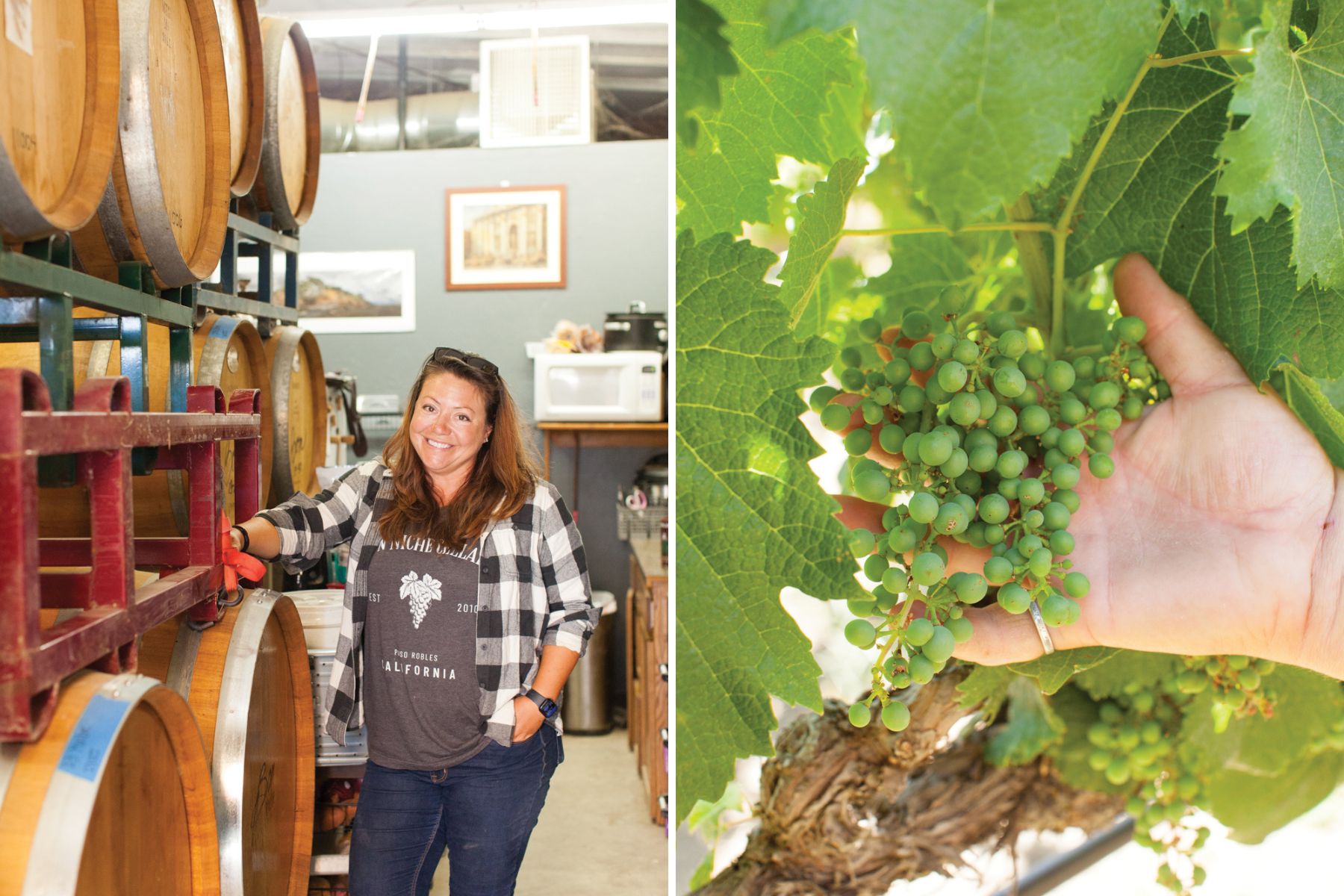
Where wine grapes now grow in San Luis Obispo County, almond trees once thrived
Story by Linda Reed
Photography by Jennifer Olson
In the silent, dark hours of the morning, farmworkers rustle grape vines to collect precious fruit for winemaking. This seasonal practice has been a fall routine for many decades, but a century ago, almonds were the prized crop in Paso Robles.
Standing among the vines of Bon Niche Cellars, Owner and Winemaker Melani Harding looks out at her seven acres of land. Varietals of Malbec, petit verdot and cabernet franc have been flourishing here since they were planted in 2009. Melani points out a much older plant growing on the surrounding hillsides beyond her grapevines. “This whole area was covered with almond trees back in the 1920s and 30s,” she says.
Today, the lion’s share of almond trees grows in the Central Valley, where plentiful irrigation supports the rapid production of 80 percent of the nation’s almonds. So, what happened to our almonds? The same conditions that allow Melani’s vines to thrive may have been the death knell for almonds.
Prunus dulcis, the scientific name for the almond tree, isn’t native to California or the U.S. Like a lot of our plants and people, it is an immigrant. Believed to have originated in what is now Iran, it spread to Spain, Morocco and Greece between 600 and 900 CE. According to research by the Almond Board of California, Spanish Franciscan padres brought slips of olive and almond trees to the Americas to plant at a string of missions along the West Coast.
Almonds arrived in Paso Robles in 1860 when pioneer William Gerst planted an orchard west of the Salinas River. Paso Robles Historical Society information shows William’s crop won the title of “Best in the World” at the 1904 World’s Fair. By 1918, Paso Robles led the world in number of acres of almonds planted, reaching almost 40,000 acres.

Almonds Take to Paso
Initially, North County seemed to be ideal; its Mediterranean climate and soil matched the native lands of Spain, Italy and Greece. Like many fruit trees, almonds require a rest period to protect them from lower winter temperatures. Once dormant, they will not resume growth, including flowering and fruit set, until they experience a level of chill. Paso Robles met that requirement.
The number of acres increased, leading to the establishment of the Paso Robles Almond Growers Association as a co-op and member of the California Almond Growers Association. In 1910, the group adopted the Blue Diamond logo and branding. The organization built a processing facility on Riverside Road, later purchased by the Farmer’s Alliance in 1936 and used for grain storage. The property is now home to Derby Winery.
The Associated Almond Growers of Paso Robles was founded in 1917. A combination land sale and almond production company, they offered buyers a chance to buy orchards in 10-acre increments and promised the opportunity to earn $2,500 a year — a tidy sum in 1920. Buyers across the country bought parcels and sat back waiting for revenue to pour in. But trouble started when some buyers discovered the parcel they were shown wasn’t the one on their documents, or it had fewer trees than promised. One man even reported that only a single tree sat on his land. Lawsuits began almost immediately and even today it is hard to say whether it was a scam or a legitimate operation.
The Independence Tracts were so named because of the financial independence the crop purported to provide. The hilly terrain in the foothills of the Temblor Range was advertised as beneficial because they kept colder temperatures away from the spring blossoms during late season frosts. This is still the case, allowing plants that can’t handle freezing temperatures during spring to survive.
Harvests were abundant the first years. However, declining rainfall totals impacted production. The hills, once seen as a benefit, now proved to be a detriment. Mechanical harvests that used new equipment to speed up picking and reduced labor costs were impeded by the steep slopes. The peach root stock chosen for the trees turned out to be short lived and impacted nut production. Almond acreage decreased in Paso Robles and by 1980, the number of planted acres shrank by a staggering 85 percent. They were eventually replaced by grape vines, which thrive in these conditions.

A Vineyard in the Heart of the Old Almond Orchard
Melani first experienced wine as a U.S. Navy nurse stationed in Naples, Italy in 2009. “I loved how wine pulled people together and I wanted to be a part of that,” she recalls.
She began volunteering for Tackitt Family Wines in 2017 to learn the craft firsthand under the tutelage of fellow Navy veteran, Leon Tackitt. She bought Bon Niche Cellars (which translates to a good place) in 2019 and began her winemaking program. She makes a collection of Bordeaux-style single varietals and blends.
The winery achieved Sustainability in Practice (SIP) certification in 2020. SIP certified brands use third-party verified sustainable practices so winemakers can feel confident their wine protects the people and the planet. Using Nigerian dwarf goats, baby doll sheep, and kunekune pigs is one part of the strategy employed to maintain sustainability.
Melani is still active in the Navy Reserves and welcomes veterans, active duty, and all wine tasters, with a laid-back farm vibe and a “welcome to the family” feel. It is a “good place” to sip wine, offering a casual tasting experience with views of the Santa Lucia mountains and the Salinas River valley.
From the Bon Niche property, some of the original almond trees can be seen clinging to the hillsides. In the fall, their golden foliage signals the beginning of a long winter sleep to prepare for the next season. No longer the star crop of the Central Coast, almonds are still plentiful in wine country — on charcuterie boards, anyway.


